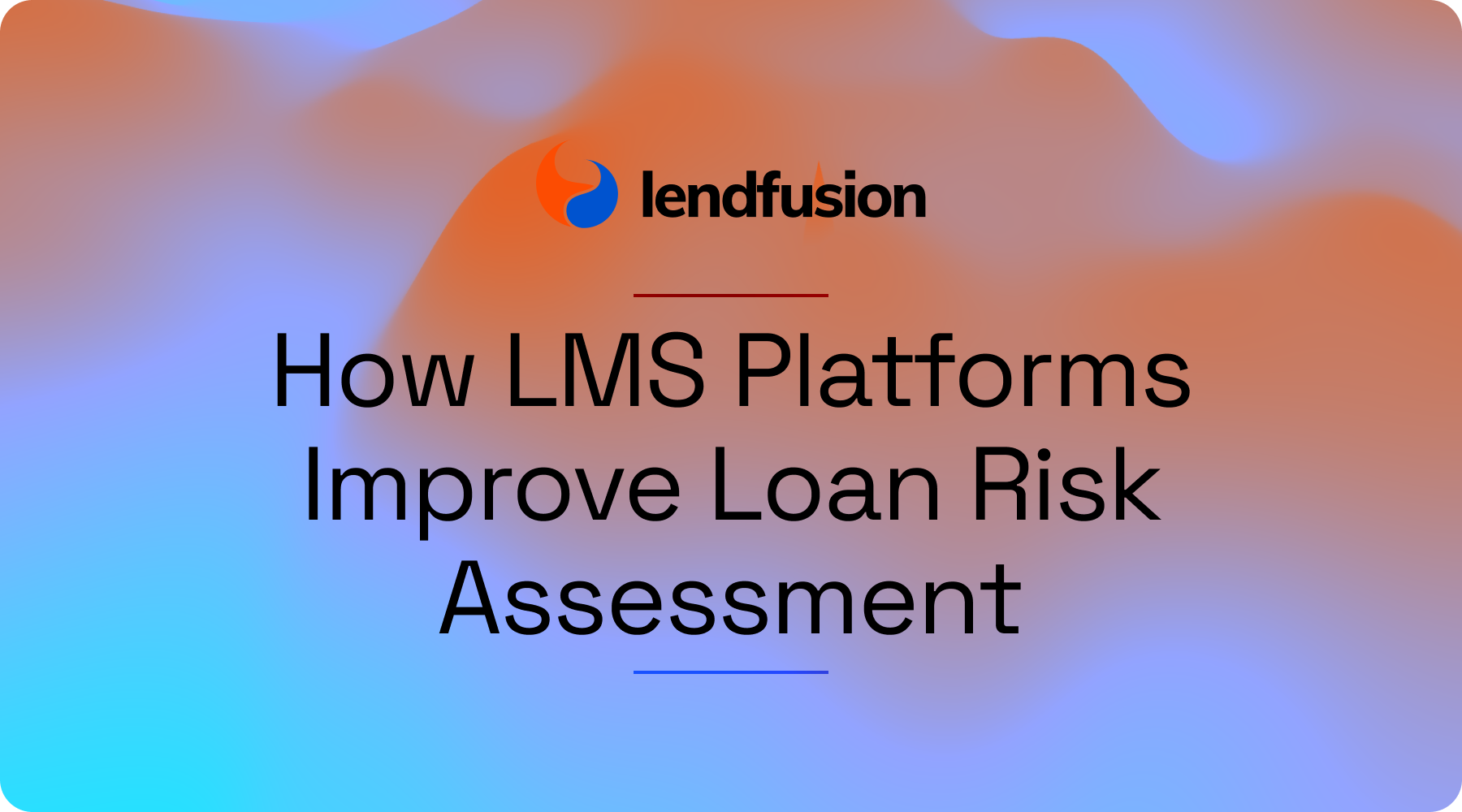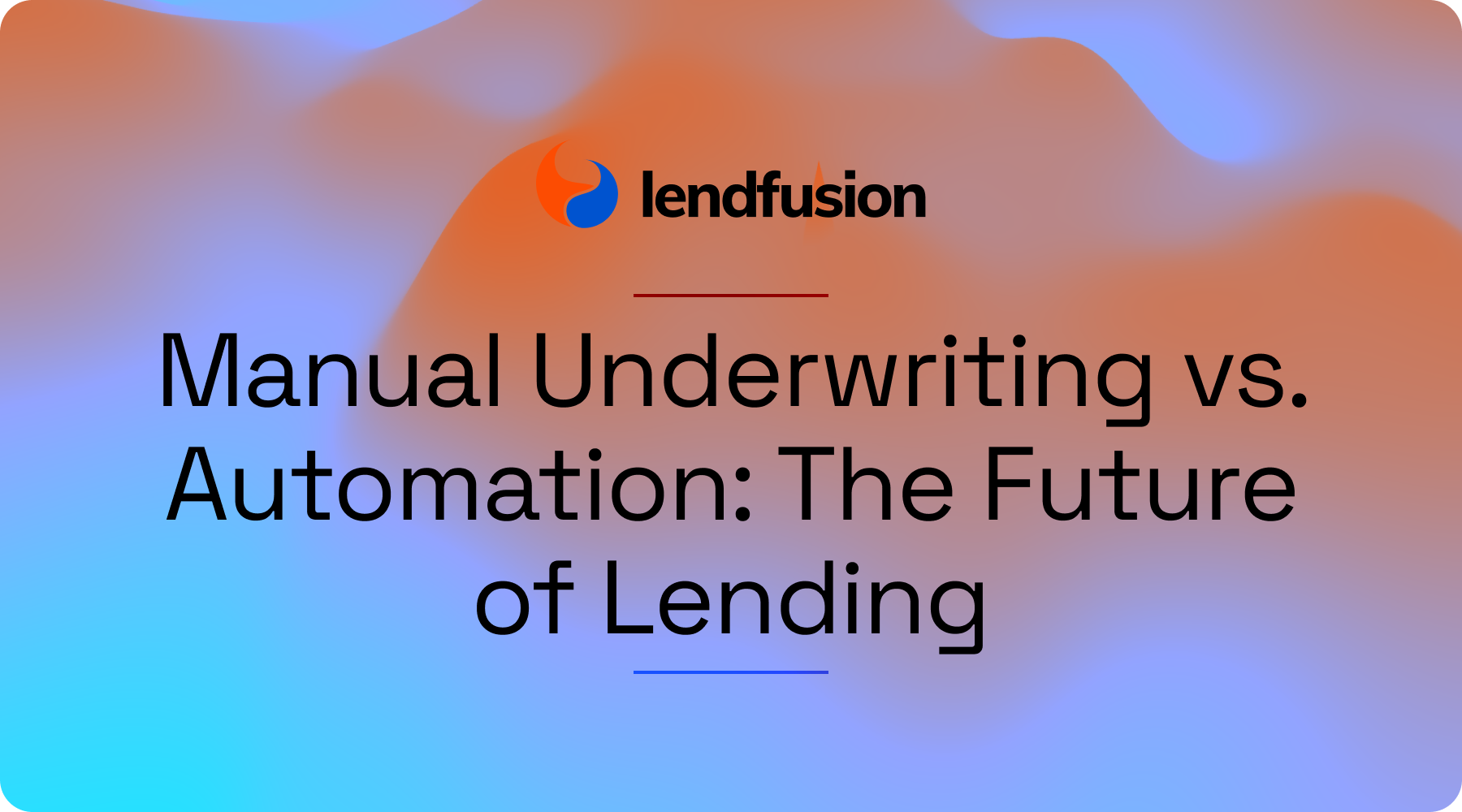How Loan Management Software Improves Loan Risk Assessment For Lenders

It’s no secret:
Loan management software has revolutionized loan risk assessment.
By automating critical tasks such as credit scoring, data analytics, and real-time monitoring, LMS platforms – like LendFusion – help lenders make informed decisions, minimize risks, and ensure regulatory compliance.
In this article, we’ll explore the key components and benefits of using loan management software for assessing and managing loan risks.
Understanding Loan Risk Assessment
Loan risk assessment helps lenders navigate the complex world of lending by offering a thorough framework for making informed decisions.
This process is critical for preserving capital by reducing the likelihood of loan defaults and optimizing the profitability of the institution’s loan portfolio.
Effective risk management is not just about financial prudence; it’s also about adhering to the regulatory mandates that uphold the banking sector’s integrity and credibility.
The introduction of loan management software has been a game-changer in this sense, offering a streamlined and automated approach to loan origination and loan processing.
Loan management software streamlines the handling of a wide array of lending products, providing lenders with the tools they need to evaluate borrower creditworthiness and manage loans throughout the entire loan lifecycle.

3 Key Components of Loan Risk Assessment in Loan Management Software
Exploring the details of loan risk assessment uncovers several essential components within loan management software.
These components work in concert to provide a robust framework for evaluating credit risk.
Credit scoring models, detailed data analytics, and thorough document verification form the core trio that supports the risk assessment capabilities of these advanced systems.
Let’s take a closer look at all three.
1. Credit Scoring Models
Credit scoring models are the basis of loan risk assessment.
These models use historical data and financial indicators to assign numerical scores, which indicate the likelihood of a borrower defaulting on a loan.
This mathematical approach to evaluating borrower creditworthiness streamlines the lending process, allowing lenders to make informed decisions with greater speed and accuracy.
Lenders that implement these models have been shown to experience a significant reduction in default rates. This clearly demonstrates the effectiveness of credit scoring in preserving capital and minimizing the risk of loan defaults.
Credit scoring models have become an indispensable tool in loan management systems.
They enhance the efficiency of the loan servicing process by providing a clear, quantifiable measure of a borrower’s financial health.
This, in turn, allows lenders to tailor their lending strategies to match the risk profile of each borrower, ensuring that credit is extended in a responsible and sustainable manner.

2. Data Analytics
Data analytics plays an invaluable role in loan management. It is the engine that powers the ability of lenders to gain valuable insights into borrower behavior and financial status.
Loan management software integrates a variety of data sources, such as credit bureaus and customer records, providing a holistic view of a borrower’s financial health.
This comprehensive perspective is crucial for identifying potential risks and making informed lending decisions.
Beyond risk assessment, data analytics also drives operational efficiency.
Automation of data collection and analysis streamlines the entire process, from loan application to repayment schedules.
Predictive modeling, an area of data analytics, enables lenders to anticipate market changes and borrower behavior, offering a proactive approach to managing loan portfolios.
3. Automated Decision-Making
Automated decision-making has radically improved the loan origination process.
These tools drastically reduce the need for manual intervention, speeding up the process and greatly increasing its reliability.
The integration of automated workflows in loan management software provides the following benefits:
- Minimizes manual tasks
- Streamlines the entire loan management process
- Ensures efficiency and accuracy
- Minimizes the risk of defaults
In today’s data-driven financial world, adopting automation is essential for lenders.
Automated decision-making tools are a testament to this shift, as they enable lenders to process loan applications and make lending decisions with greater confidence and precision.
This automation is a crucial aspect of effective loan management, resulting in a more seamless borrower experience and enhanced financial health for both the lender and the borrower.

How Loan Management Software Enhances Risk Management Processes
Loan management software represents a major advancement in how lenders manage risk.
These systems:
- Automate core processes
- Capitalize on the power of real-time monitoring, predictive analytics, and document verification
- Enhance the entire risk management process
- Provide lenders with an unprecedented level of control and insight into their loan portfolios.
Let’s explore these in more detail.
Real-Time Monitoring
Real-time monitoring uses analytics to deliver updates on loan performance as they occur, enabling lenders to maintain the quality of their loan portfolio.
This continuous tracking aids in detecting any shifts in borrower behavior, allowing financial institutions to take proactive measures to mitigate risks before they materialize into significant issues.
Some benefits of real-time monitoring include:
- Immediate detection of potential risks
- Timely intervention to prevent defaults or delinquencies
- Enhanced decision-making based on up-to-date information
- Improved portfolio management and risk assessment
By implementing real-time monitoring, lenders can stay ahead of potential problems and ensure the health and stability of their loan portfolio.
In addition, real-time monitoring supports regulatory compliance by ensuring that all loan activities are tracked and recorded. This results in a comprehensive audit trail that can be invaluable during compliance checks and reviews.
By automatically maintaining financial documents and tracking loan performance, loan servicing software streamlines the servicing process, ensuring that lenders can focus on optimizing their portfolio performance.
Predictive Analytics
Predictive analytics offer insights into future risks and borrower behaviors.
It also supports by:
- Analyzing historical data
- Identifying patterns
- Forecasting potential risks
- Enabling lenders to make informed decisions
- Optimizing loan portfolios
These advanced analytics and algorithms provide accurate credit assessments and proactive risk management, which are essential for maintaining a healthy loan portfolio.
Machine learning technologies, a core component of predictive analytics, use large volumes of data to predict outcomes such as the risk of default or late payments.
This level of analysis allows lenders to customize their loan products to better fit the risk profiles of their borrowers, reducing their exposure to riskier loans and enhancing overall loan portfolio performance.

Document Verification
Document verification is the foundation of accuracy and compliance in the loan management process.
Automated document verification processes not only reduce the risk of human error but also enhance the reliability of the risk assessment itself.
As lenders move towards online loan application software, the ability to submit and verify documents digitally has become more important than ever.

This not only ensures the accuracy of the information provided but also connects with credit bureaus to assess credibility, ensuring that all data is up-to-date and accurate.
Secure data management is another critical aspect of document verification.
Loan management software converts traditional documents into secure digital formats, minimizing exposure to security risks and ensuring sensitive client information is protected.
This level of security is indispensable in today’s digital age, where data breaches can have catastrophic consequences for both financial institutions and their customers.
Benefits of Using Loan Management Software for Risk Assessment
The use of loan management software for risk assessment offers a wide range of benefits that extend far beyond just enhanced risk management.
These systems are improving the way lenders operate, from automating manual processes and delivering comprehensive reports to improving compliance.
Enhanced Efficiency
Loan automation has been shown to increase operational efficiency by 30%, significantly accelerating loan approval times and reducing the incidence of manual errors.
By expediting processes such as data interpretation, loan approvals, and disbursement, these systems allow staff to concentrate on tasks that require complex decision-making, rather than getting bogged down in routine, manual work.
This enhancement in efficiency extends to the customer as well. Automated payment reminders, for instance, have been shown to lead to a 25% reduction in late payments, improving customer satisfaction and reducing the risk of delinquency.
When lending operations are streamlined, everyone benefits—lenders can serve their customers more effectively, and customers enjoy a smoother, more responsive borrowing experience.

Comprehensive Reports
Comprehensive reports generated by loan management software are invaluable tools for informed decision-making. By leveraging predictive analytics, these reports provide in-depth insights into the performance of the loan portfolio, helping lenders to:
- Identify trends
- Make strategic decisions
- Track and analyze key performance indicators such as loan approval times, delinquency rates, and customer satisfaction scores
These reports are essential for assessing the success of loan management strategies.
The ability to generate detailed reports offers several benefits, including:
- Aid in transparency and accountability
- Effective communication with stakeholders, including investors, regulatory bodies, and customers
- Refinement of risk assessment processes
- Improvement of product offerings
- Driving institution’s growth
Improved Compliance
One of the most significant benefits of loan management software is the improvement it brings to regulatory compliance.
Automated compliance checks, integrated with external databases, ensure that lenders adhere to the latest regulatory standards, reducing the risk of non-compliance.
Digitized document management features also aid in preventing identity theft and financial fraud, further enhancing the security and integrity of the lending process.
Plus, the use of automated workflows and centralized repositories of communications and documents ensures transparency and facilitates compliance with regulatory requirements.
With robust security measures in place, sensitive client information is safeguarded, ensuring that the lender’s reputation remains untarnished.
These improvements not only benefit the institution in terms of avoiding penalties and fines but also improve customer trust and satisfaction.

Choosing the Right Loan Management Software for Risk Assessment
Choosing the right loan management software for risk assessment can be a challenge.
It requires a careful balancing act between assessing business needs, evaluating software features, and considering the costs involved.
The goal is clear: to find a solution that aligns with your specific needs and goals, and that can adapt to the evolving landscape of the lending industry.
Assessing Business Needs
The first step in the selection process is to assess the business needs. This involves:
- Identifying core functional requirements such as loan origination and loan servicing
- Considering the types of loans to be managed
- Evaluating the desired level of automation and determining whether the software can scale with the business’s anticipated growth
- Taking into account the needs of all user groups and stakeholders within the company to ensure that the selected software supports the company’s strategy and meets user expectations.
Evaluating Features
Evaluating features is another key aspect of choosing the right loan management software. The system should offer comprehensive capabilities, including:
- Loan origination
- Servicing
- Collections
- Detailed reporting
Integration capabilities with other core systems, such as banking, accounting, and customer relationship management (CRM) systems, are also vital for ensuring operational efficiency.

Security is a non-negotiable feature.
The software must meet industry security standards and include features such as encryption and role-based access controls to protect sensitive data.
Additionally, the delivery model of the software, whether it’s a Software as a Service (SaaS) model or cloud-based, and its accessibility across different devices and operating systems, are important considerations for ensuring that all stakeholders can effectively interact with the system.
Considering Costs
Lenders must evaluate the license fees, implementation costs, and the ongoing maintenance fees associated with the software.
These costs can vary widely, ranging from $45,000 to $200,000, with development timelines spanning from 5 to 12 months, depending on the complexity and customization required.
Another thing:
The total cost of ownership includes not just the upfront expenses but also the annual or monthly costs for support, updates, and upgrades.
It’s important to consider the size of the business, the type of loans handled (i.e. consumer loans vs commercial loans), and the level of customization desired, as all these factors will influence the cost equation.
By carefully evaluating these aspects, lenders can make cost-effective decisions that align with their risk assessment needs and overall business objectives.
Conclusion
Loan management software serves as a strategic ally for lenders, not just a tool.
It enhances lending processes through automated pre-qualification, document management, and payment scheduling, ensuring a seamless and compliant loan lifecycle.
The integration of workflow automation in loan management systems significantly reduces manual labor and potential errors, which translates to increased efficiency and accuracy.
The ability of loan management software includes:
- Facilitating real-time compliance checks
- Generating detailed audit trails
- Centralized data storage
- Automated workflows
- Advanced analytics
Put simply:
Loan management software is an essential investment for lenders looking to optimize their loan processes and mitigate risks effectively.
Better Loan Risk Assessment With LendFusion
LendFusion helps you streamline the entire loan risk assessment process.
As a LendFusion customer, you can stay ahead of the curve, ensuring you can make informed decisions, optimize your loan portfolios, and comply with ever-evolving regulatory standards.
Ready to transform your loan risk assessment process?
Book a demo with LendFusion today!


Andres Valdmann, CEO
Andres is the Chief Executive Officer at LendFusion. Andres has 15 years of experience in fintech and loan management software and has a proven track record in helping companies hit their growth goals.



